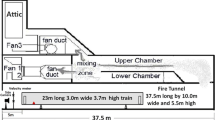Abstract
Fourteen full-scale fire tests were carried out during 2000/2001 in the Second Benelux Tunnel near Rotterdam in the Netherlands. The tests were designed to assess the tenability conditions for escaping motorists in case of a fire in a Dutch road tunnel and to study the effect of mitigating measures on these conditions. In particular, the effects of detection systems, mechanical ventilation and sprinklers were investigated. Several types of fire sources were used: fuel pans, cars, a van and covered truck loads. Temperatures, radiation levels and optical densities in the tunnel were measured, as well as smoke velocities and heat release rates. Furthermore, video recordings were made of the fire development and smoke propagation in the tunnel. The information collected about the effect of the fire development, and the use of longitudinal ventilation and sprinklers, was used to evaluate the possibility of self-rescue for escaping people.
Similar content being viewed by others
References
Steunpunt Tunnelveiligheid: Project ‘Safety Test’’ Report on Fire Tests, published by Directorate-General for Public Works and Water Management, Utrecht, August 2002. http://www.tunnelsafety.nl.
J. Huijben, “Tests on Fire Detection Systems and Sprinkler in a Tunnel,” in Tunnel Fires and Escape from Tunnels, Fourth Int. Conference, Basel, 2–4 December 2002, pp. 73–82.
(In Dutch) A.D. Lemaire, P.H.E. van der Leur, and Y.M. Kenyon, “Safety Proef: TNO Metingen Beneluxtunnel,” TNO-rapport nr 2002-CVB-R05572, Delft, 2002.
(In Dutch) A.D. Lemaire, P.H.E. van der Leur, and Y.M. Kenyon, “Safety Proef: Evaluatie Metingen Rook- en Warmtegedrag in de Beneluxtunnel,” TNO-rapport nr 2002-CVB-R05573, Delft, 2002.
G.T. Atkinson, et al. “Fire Tests and CFD Modelling of Critical Velocity Behaviour,” in Smoke and Critical Velocity in Tunnels, ITC seminar London, April 1996, pp. 13–24.
R.O. Carvel, A.N. Beard, and P. W. Jowitt, “Variation of Heat Release rate with Forced Longitudinal Ventilation for Vehicle Fires in Tunnels,” Fire Safety Journal, vol. 36, 2001, pp. 569–596.
J. Huijben, “The Influence of Longitudinal Ventilation on Fire Size and Development,” in Tunnel Fires and Escape from Tunnels, Fourth Int. Conference, Basel, 2–4 December 2002, pp 115–124.
Building Exodus v3.0 Manual, Greenwich University, London, 2001.
PIARC, Fire and Smoke Control in Road Tunnels, 1999.
CPR 16E. Methods for the Determination of Possible Damage, The Green Book, 1992.
H. Hunseid and K.O. Ingebrigtsen, Human Resistance against Thermal Effects, Explosion Effects, Toxic Effects, and Obsuration of Vision, Report DNV Technica en Scandpower A/S, 2001.
T. Jin, “Visibility and Human Behavior in Fire Smoke,” SFPE Handbook of Fire Protection Engineering, 3rd edition, National Fire Protection Association Inc., Massachusetts, 2002, pp. 2–42 to 2–53.
D.A. Purser, “Toxicity Assesment of Combustion Products,” SFPE Handbook of Fire Protection Engineering, 3rd edition, National Fire Protection Association Inc, Massachusetts, 2002, pp. 2–83 to 2–171.
Author information
Authors and Affiliations
Rights and permissions
About this article
Cite this article
Lemaire, T., Kenyon, Y. Large Scale Fire Tests in the Second Benelux Tunnel. Fire Technol 42, 329–350 (2006). https://doi.org/10.1007/s10694-006-8434-4
Published:
Issue Date:
DOI: https://doi.org/10.1007/s10694-006-8434-4




